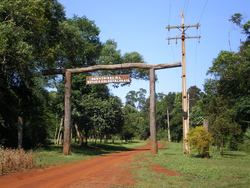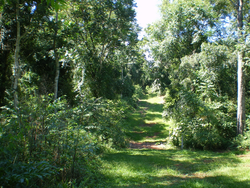
Refugio Carapá
Encyclopedia
The biological Reserve Carapa is located in the Department of Canindeyú
, Paraguay
, on the right bank of the river Paraná, and is one of the sites earmarked as 8 ecological reserve by the Itaipu, the largest dam in production in the world, located between Paraguay and Brazil. It is located at 260 km north of the Ciudad del Este
. It was founded in 1984 and has 3,250 has
.

, Peltophorum dubium and Cedrela fissilis
.
Of the animal species recorded, most are in the range of endangered, among those mentioned: Lobo water (Lutra longicaudis), Pork Mount (collared peccary
), among carnivores Felis
, people are casual because it is part of its territorial displacement. Of all the species recorded in the area of Itaipu dam, 61.4% belong to the River area Carapâ.
Overall objective of the refuge:
 This reserve, bordering Lake is artificially created by Itaipu. Being formed in 1982, a series of economic alternatives that are already beginning to be exploited by the 77 neighboring municipalities. The artificial lake is one of the largest in the world, with 29 million m³ and 200 km extension in a straight line. Considering the bays, inlets and length reaches 1,400 km.
This reserve, bordering Lake is artificially created by Itaipu. Being formed in 1982, a series of economic alternatives that are already beginning to be exploited by the 77 neighboring municipalities. The artificial lake is one of the largest in the world, with 29 million m³ and 200 km extension in a straight line. Considering the bays, inlets and length reaches 1,400 km.
The formation of the lake has not only changed the look of the geographic region. The agriculture, regional economic base, begins to cede place to tourism. Several artificial beaches were created along the banks of the lake, where he practiced all sorts of water sports.
The reserve has a panoramic viewpoint, which can be seen most of the wooded area, as well as the vast body of water formed by the dam. The combined resources of vegetation, topography and water give it a priceless value.
Canindeyú Department
Canindeyú is a department in Paraguay. The capital is the city of Salto del Guairá.-Districts:The department is divided in 11 districts:# Corpus Christi# Curuguaty# General Francisco Caballero Alvarez # Itanará# Katueté# La Paloma...
, Paraguay
Paraguay
Paraguay , officially the Republic of Paraguay , is a landlocked country in South America. It is bordered by Argentina to the south and southwest, Brazil to the east and northeast, and Bolivia to the northwest. Paraguay lies on both banks of the Paraguay River, which runs through the center of the...
, on the right bank of the river Paraná, and is one of the sites earmarked as 8 ecological reserve by the Itaipu, the largest dam in production in the world, located between Paraguay and Brazil. It is located at 260 km north of the Ciudad del Este
Ciudad del Este
Ciudad del Este is the second largest city in Paraguay and capital of Alto Paraná department, located at the Rio Paraná....
. It was founded in 1984 and has 3,250 has
Hectare
The hectare is a metric unit of area defined as 10,000 square metres , and primarily used in the measurement of land. In 1795, when the metric system was introduced, the are was defined as being 100 square metres and the hectare was thus 100 ares or 1/100 km2...
.
Geography
Surrounded by mountains and land with very steep slopes. The soils are the type latosol textured red clay.
Weather
The weather is warm, humid and warm resulting in the overall situation in the sub mesotermal humid tropics. Annual precipitation of 1,300 mm. The drainage basin of the river Carapâ is composed of several tributaries that arise in different parts of the Department of Canindeyu (Paraguay).Animals and plants
The vegetation of the refuge is composed of associations of forest high, low forest, swamps, high camp, camp low, primitive forest and forest near the river. The dominant species are composed of: TabebuiaTabebuia
Tabebuia is a neotropical genus of about 100 species in the tribe Tecomeae of the family Bignoniaceae. The species range from northern Mexico and southern Florida south to northern Argentina, including the Caribbean islands of Hispaniola and Cuba...
, Peltophorum dubium and Cedrela fissilis
Cedrela fissilis
Cedrela fissilis is a species of plant in the Meliaceae family. It is found in Argentina, Bolivia, Brazil, Colombia, Costa Rica, Ecuador, Panama, Paraguay, Peru, and Venezuela. This plant is currently threatened by habitat loss.-Source:...
.
Of the animal species recorded, most are in the range of endangered, among those mentioned: Lobo water (Lutra longicaudis), Pork Mount (collared peccary
Collared Peccary
The collared peccary is a species of mammal in the family Tayassuidae that is found in North, Central, and South America. They are commonly referred to as javelina, saíno or báquiro, although these terms are also used to describe other species in the family...
), among carnivores Felis
Felis
Felis is a genus of cats in the family Felidae, including the familiar domestic cat and its closest wild relatives. The wild species are distributed widely across Europe, southern and central Asia, and Africa; the domestic cat has been introduced worldwide.Members of the genus Felis are all small...
, people are casual because it is part of its territorial displacement. Of all the species recorded in the area of Itaipu dam, 61.4% belong to the River area Carapâ.
Infrastructure and use of refuge
The refuge has a structure in which edilicia living and working professionals and technicians on a permanent basis.Overall objective of the refuge:
- Study of the environmental situation in the drainage basin of river Carapâ
- Study of the mastofauna birds and fish
- Study of the environmental situation in the drainage basin of river Carapâ
- Study of the mastofauna birds and fish
- Studying the formation floristic
- Study of physical and chemical conditions of water
- Study of climatic conditions
- Studies soil
- Social aspects
- Analysis and classification of the ecosystem for its operating framework within a category conservationist
Itaipu Lake

The formation of the lake has not only changed the look of the geographic region. The agriculture, regional economic base, begins to cede place to tourism. Several artificial beaches were created along the banks of the lake, where he practiced all sorts of water sports.
Area subdivision
According to latest techniques of management of protected areas, this refuge is divided into distinct zones in order to handle them properly.- Areas of special use: areas include reduced in size and which are essential for the administration, office accommodation, restaurant, aviation runway, and so on
- Zone extensive use: areas to which visitors access for education and recreation (and self-guided interpretive trails, paths "cross country", etc.)
- Zones intensive: consist of areas with outstanding scenery and that lend themselves to relatively dense recreational activities (camping areas, visitors' centers and scenic lookouts)
- Buffer Zones and Recovery: areas that have been severely damaged and it is mostly to areas adjacent to the surrounding populations
- Zone Core: natural areas that have received the minimum of disruption caused by man (with three distinct nuclei and characteristic of the place)
The reserve has a panoramic viewpoint, which can be seen most of the wooded area, as well as the vast body of water formed by the dam. The combined resources of vegetation, topography and water give it a priceless value.

